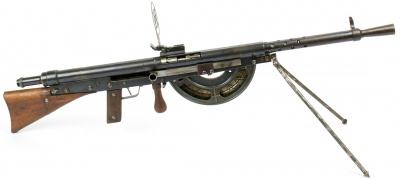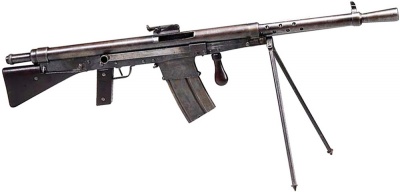| If you have been locked out of your account you can request a password reset here. |
Difference between revisions of "Chauchat"
| Line 3: | Line 3: | ||
The Chauchat would later be known as one of the most ineffective machine guns ever produced. Due to what appears to have been a personal feud between the US Army Chief of Ordnance, General William Crozier, and Colonel Isaac Newton Lewis, inventor of the [[Lewis Gun]], the US Army not only never adopted the Lewis Gun but actually confiscated Lewis Guns from Marines who had them. Further, General Pershing was extremely loathe to deploy the new Browning Automatic Rifle until victory was certain, for fear that the Germans would copy it. Instead, the American Expeditionary Force were issued with Chauchats, initially 16,000 in 8mm Lebel but later 19,000 hastily manufactured chambered for .30-06, often with incomplete reaming and dimensional errors from rushed production: American inspectors at the Gladiator plant producing .30-06 Chauchats reported they had rejected over 40% of weapons produced. The far more powerful .30-06 cartridge did not in any way agree with the mechanism, which typically failed to extract the instant the action started to heat up after a few shots: this also happened with the standard 8mm Lebel variant, which would lock up with the bolt jammed in the rearward position after about 120 rounds of sustained fire due to thermal expansion and not unlock until the weapon cooled down. | The Chauchat would later be known as one of the most ineffective machine guns ever produced. Due to what appears to have been a personal feud between the US Army Chief of Ordnance, General William Crozier, and Colonel Isaac Newton Lewis, inventor of the [[Lewis Gun]], the US Army not only never adopted the Lewis Gun but actually confiscated Lewis Guns from Marines who had them. Further, General Pershing was extremely loathe to deploy the new Browning Automatic Rifle until victory was certain, for fear that the Germans would copy it. Instead, the American Expeditionary Force were issued with Chauchats, initially 16,000 in 8mm Lebel but later 19,000 hastily manufactured chambered for .30-06, often with incomplete reaming and dimensional errors from rushed production: American inspectors at the Gladiator plant producing .30-06 Chauchats reported they had rejected over 40% of weapons produced. The far more powerful .30-06 cartridge did not in any way agree with the mechanism, which typically failed to extract the instant the action started to heat up after a few shots: this also happened with the standard 8mm Lebel variant, which would lock up with the bolt jammed in the rearward position after about 120 rounds of sustained fire due to thermal expansion and not unlock until the weapon cooled down. | ||
| − | Additional problems included the poorly designed magazines, made of thin metal that deformed easily and with an opening on the right-hand side which allowed mud and debris to enter freely, which were responsible for some 75% of stoppages by themselves, all Gladiator guns having sights incorrectly set low and to the right, poor ergonomics and a loose bipod making the weapon inaccurate outside short bursts, and a tendency to fail to feed on the first round if the magazine was fully loaded. To top all this off, it is unclear if US forces received any instructions in operating the Chauchat: no American service manual for the .30-06 version has ever been found. Almost all .30-06 Chauchats appear to have been thrown away by their operators. | + | Additional problems included the poorly designed magazines, made of thin metal that deformed easily and with an opening on the right-hand side which allowed mud and debris to enter freely, which were responsible for some 75% of stoppages by themselves, all Gladiator guns having sights incorrectly set low and to the right, poor ergonomics and a loose bipod making the weapon inaccurate outside short bursts, and a tendency to fail to feed on the first round if the magazine was fully loaded. To top all this off, it is unclear if US forces received any instructions in operating the Chauchat: no American service manual for the .30-06 version has ever been found. Almost all .30-06 Chauchats that reached the front line appear to have been thrown away by their operators. |
The Chauchat was replaced in French service by the FM 24/29 light machine gun, a weapon based on the Browning Automatic Rifle action, but saw limited use in World War 2. | The Chauchat was replaced in French service by the FM 24/29 light machine gun, a weapon based on the Browning Automatic Rifle action, but saw limited use in World War 2. | ||
Revision as of 13:30, 25 September 2017
The Chauchat, officially the Fusil Mitrailleur Modele 1915 CSRG ("Machine Rifle Model 1915 Chauchat, Sutter, Ribeyrolles and Gladiator") was a French light machine gun that went into service in 1908 for use by the French Army, primarily during the First World War. The weapon was built according to the same concept as the Browning Automatic Rifle, a "walking fire" gun that could be fired from the hip by an advancing soldier to suppress an enemy trench line. It was an extremely unusual design in that it used gas-assisted long recoil operation in a fully-automatic firearm, creating a very low rate of fire of 240rpm, and had a bizarre U-shaped 20-round magazine to accommodate the sharply tapered 8x50mmR Lebel round.
The Chauchat would later be known as one of the most ineffective machine guns ever produced. Due to what appears to have been a personal feud between the US Army Chief of Ordnance, General William Crozier, and Colonel Isaac Newton Lewis, inventor of the Lewis Gun, the US Army not only never adopted the Lewis Gun but actually confiscated Lewis Guns from Marines who had them. Further, General Pershing was extremely loathe to deploy the new Browning Automatic Rifle until victory was certain, for fear that the Germans would copy it. Instead, the American Expeditionary Force were issued with Chauchats, initially 16,000 in 8mm Lebel but later 19,000 hastily manufactured chambered for .30-06, often with incomplete reaming and dimensional errors from rushed production: American inspectors at the Gladiator plant producing .30-06 Chauchats reported they had rejected over 40% of weapons produced. The far more powerful .30-06 cartridge did not in any way agree with the mechanism, which typically failed to extract the instant the action started to heat up after a few shots: this also happened with the standard 8mm Lebel variant, which would lock up with the bolt jammed in the rearward position after about 120 rounds of sustained fire due to thermal expansion and not unlock until the weapon cooled down.
Additional problems included the poorly designed magazines, made of thin metal that deformed easily and with an opening on the right-hand side which allowed mud and debris to enter freely, which were responsible for some 75% of stoppages by themselves, all Gladiator guns having sights incorrectly set low and to the right, poor ergonomics and a loose bipod making the weapon inaccurate outside short bursts, and a tendency to fail to feed on the first round if the magazine was fully loaded. To top all this off, it is unclear if US forces received any instructions in operating the Chauchat: no American service manual for the .30-06 version has ever been found. Almost all .30-06 Chauchats that reached the front line appear to have been thrown away by their operators.
The Chauchat was replaced in French service by the FM 24/29 light machine gun, a weapon based on the Browning Automatic Rifle action, but saw limited use in World War 2.
Specifications
(1908-1945)
- Type: Light Machine Gun
- Weight: 9.07 kilograms (20 lb)
- Length: 1,143 millimeters (45 in)
- Barrel length: 470 millimeters (18.5 in)
- Cartridge: 8x50mmR Lebel (French), .30-06 (US), 7.92x57mm Mauser (Polish), 7.65x53mm Argentine (Belgian)
- Action: Long recoil with gas assist
- Rate of fire: ~240 rounds/min
- Muzzle velocity: 630 m/s
- Effective range: 200 m
- Maximum range: 2000 m
- Feed system: 20-round magazine
- Fire modes: Semi / auto
The Chauchat can be seen in the following:
Film
| Title | Actor | Character | Note | Date |
|---|---|---|---|---|
| Young, Violent, Dangerous (Liberi armati pericolosi) | Seen in Lucio's collection | 1976 | ||
| Assassin of the Tsar | Seen in the guard's room | 1991 | ||
| Capitaine Conan | French soldiers | 1996 | ||
| The Lost Battalion | Daniel Caltagirone | Pvt. Phillip Cepeglia | 2001 | |
| George Calil | Pvt. Lowell R. Hollingshead | |||
| Arthur Kremer | Pvt. Abraham Krotoshinsky | |||
| A Very Long Engagement | French soldier | 2004 | ||
| Battle of Warsaw 1920 | Polish soldier | 2011 |
Television
| Show Title / Episode | Actor | Character | Note | Air Date |
|---|---|---|---|---|
| Lock 'n Load With R. Lee Ermey (Episode 1 "Machine Gun Educations") | . | . | . | ? |
Video Games
| Game Title | Mods | Notations | Release Date |
|---|---|---|---|
| Fallout Tactics | . | Cannot be fired, appears as an easter egg | 2001 |
| Battlefield: 1918 | 2004 | ||
| Battle of Empires : 1914-1918 | Chauchat | 2014 | |
| Verdun | "Fusli Mitrailleur Mle 1915 CSRG Chauchat" "US CRSRG .30-06 M1918 Chauchat" |
2015 | |
| Battlefield 1 | Chauchat | "They Shall Not Pass" DLC | 2016 |
Anime
| Film Title | Character | Note | Date |
|---|---|---|---|
| Fullmetal Alchemist: Brotherhood | Amestrian soldier | 2009 - 2010 | |
| The Mystic Archives of Dantalian | Suitor | 2011 |

